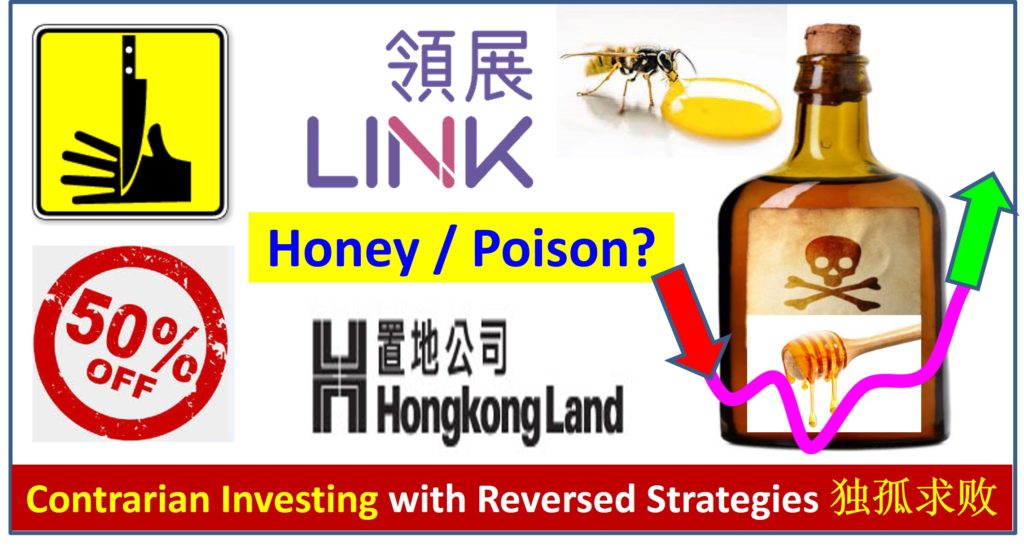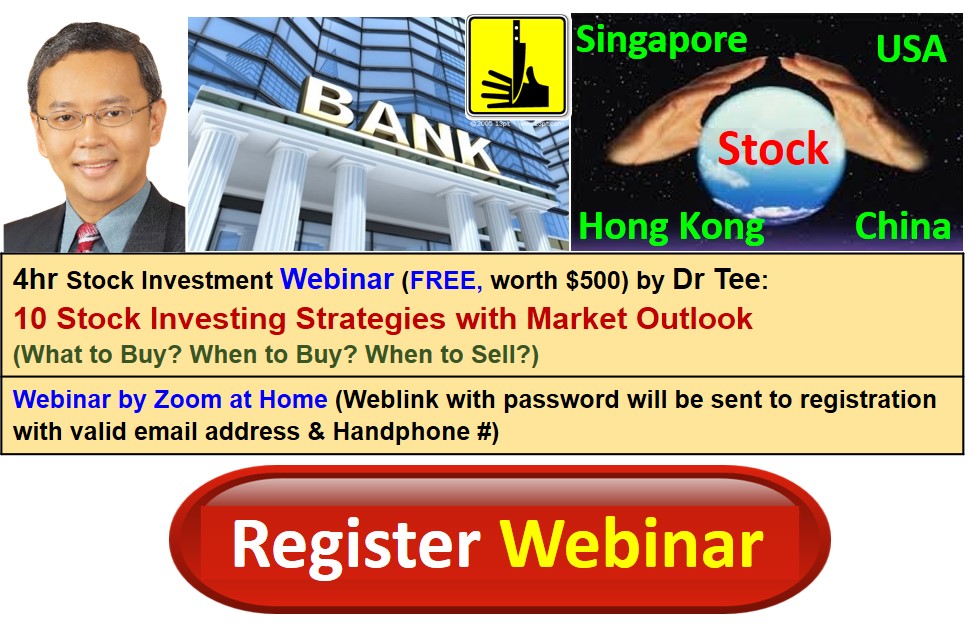
Contrarian investing is a unique stock strategy (eg. Buy Low Sell High) which goes against the majority or popular views as usually the big winner in an emotional stock market is minority. However, there are both hidden risks and opportunities of this strategy if not aligned properly with own personality, “honey” may become “poison” for an investor.
Let’s learn the 6 key factors of contrarian investing from Dr Tee, then applying in 2 Singapore and Hong Kong dividend giant stocks:
1) Singapore Dividend Giant Stock: Hongkong Land (SGX: H78)
2) Hong Kong Dividend Giant Reit: Link Reit (HKEX: 0823)
The best example of contrarian investor is probably Warren Buffett who believes in “Be Greedy when others are Fearful. Be Fearful when others are Greedy” (独孤求败). He has practiced this method for decades to “Buy Low Sell High” or “Buy Fair price and Hold”, proven to work for him. However, knowing does not mean the same strategy may be suitable for you.
Here are 6 key factors for contrarian investing to work:
1) Value of a company should come first before considering to buy at lower price with contrarian investing of any stock. In order to minimize the chances of “Buy Low get Lower”, a strong defensive and growing business with wide moat should be the core pillar, not just based on price alone.
2) Contrarian investing is more suitable for mid term and long term investor. As Warren Buffett said, “Stock behaves like a weighing machine in longer term”, meaning price eventually follows strength of business fundamental while “stock is like a voting machine in shorter term” (emotional prices regardless of business). It is possible (although rare) for short term investor to apply contrarian trading but this is mainly for those traders who are willing to integrate trading with long term investing, eg. when buying at 10% dip (near intermediate price support), willing to hold longer term if share price could not recover in short term with over 10% gains.
3) Timing of entry/exit for contrarian investors is usually against the majority (mass market, usually following price trends). For example, when a stock is bearish in share price (while business is intact), a contrarian investor would start to plan for entry. However, Buy Low may get lower (even for stocks with strong businesses) in a bearish market, therefore a contrarian investor may consider “Average Down” strategy, eg. entry with batches (5 x 20%) or (2 x 50%), etc. When Dr Tee Optimism strategies (Long Term / Mid Term) could be integrated, the positioning would be more systematic. Alternatively, a contrarian investor may wait for the bearish (downtrend) price to at least go sideways (eg. buying near or above strong price support) if not willing to wait for stronger price reversal to uptrend (trend-follower).
4) Alignment with Level Analysis, eg. Level 2 (Sector), Level 3 (Country) and Level 4 (World), is crucial for Contrarian Investor, eg. Buy Low during low Optimism (<25%) with Global Financial Crisis, Sell High during high Optimism (>75%) with historical best economic and stock performances. With such alignment, usually law makers of each country may provide additional support (eg. QE or printing money) during financial crisis, easier for stock to recover. Similarly, a government may cool down the stock market when economy is overheated, especially with high inflation (eg. interest rate hike).
5) Dividend giant stocks would help a contrarian investor to generate passive incomes (eg. >5-10+% dividend yield) during the difficulty time. Eg. over the past 1 year of global tech stocks correction, when growth stocks do not grow in share prices, an investor may suffer capital loss (if holding growth stocks with 0 dividend) or zero / little return (if holding cash).
6) Regardless how confident is an investor on any stock or business (including giant stock), there are always potential unsystematic risks which could be beyond the control, although it may be rare but it is never zero risk. Therefore, it is prudent to diversify over 10-20 giant stocks as a portfolio or through a giant index ETF. Even when a stock may fall to $0 or business goes bankrupt, the potential maximum capital loss of portfolio is limited to only 5-10%. Eg. if there is a portfolio of 20 dividend giant stocks with 5% dividend yield, it could generate $5 from every $100 investment yearly, therefore even if 1/20 stock may disappear ($5 loss) under very rare condition, the dividend yield ($5) could be sufficient to balance the risk of holding in long term.
Similarly, a contrarian investor would also Sell in an overheated stock market with over 75% Optimism while most trend-following traders would think this is the best time for trading. So, whether contrarian investing is “honey” (eg. Buy Low Sell High) or “poison” (eg. Buy Low Get Lower), it depends on how much integration of 6 factors above to own unique personality (eg. short term / medium term / long term). There is no best strategy in the world for stock investing but one has to find the most suitable one for own personality (eg. contrarian vs trend-following, long term investing vs short term trading, fundamental vs technical, etc).
Let’s apply contrarian investing on these 2 Singapore and Hong Kong dividend giant stocks:
1) Singapore Dividend Giant Stock: Hongkong Land (SGX: H78)
Hongkong Land has nearly 100 years of business record in property market, part of Jardine Group with about 200 years of history in China. Due to slowing Hong Kong economy and property market (especially during last 3 years of pandemic), Hongkong land share price has dropped by half over the past 5-7 years from peak price of $8+ to low prices of about $4+.
The share prices have even dropped below $4 during 2020 and 2022, the 2 worse times of pandemic in Hong Kong / China, recovering and supporting above $4 resistance (becoming support currently). A contrarian investor may consider Hongkong Land stock below $5, averaging down if needed if falling to $4.50, $4 or below. Assuming the stock may go bearish or sideways, an investor may collect about 5% dividend yield currently (higher yield if share price bought is lower), higher than Singapore Savings Bond of 3% interest (purely passive income, no potential capital gain).
More importantly, Hongkong Land has 2/3 investment properties (mostly collecting rental in Hong Kong / Singapore / China, behaving like a Reit with strong rental business) and 1/3 development properties (mostly in China, having a mega project with $4 Billions investment in West Bund of Shanghai). China / HK has ended zero COVID policy, Hongkong Land business is expected to recover strongly (especially for development projects in China) with this Level 3 (country) alignment of policy.
Hongkong Land is still at low Ein55 Optimism (<25%) but recovering well from correction in China pandemic 2022, aiming for Ein55 intrinsic value of about $8+/share or over $10/share when market emotion may be greedy again. The stock is well balanced, could be suitable for dividend investing (Buy & Hold for dividend), growth investing (Buy & Hold for capital gains), cyclic investing (Buy Low Sell High) but not for trading (downtrend for short term). Hongkong Land is not a Reit but having the stability as a Reit with strong business (value), therefore may be considered for contrarian investing by some investors.
For investors with limited capital, not able to diversify over 10-20 dividend giant stocks, Singapore STI index has 30 stocks (including Hongkong Land) with 4% dividend yield, may be considered for contrarian investing but not ideal at current near fair price (40+% Optimism), may need to wait till the next Global Financial Crisis to buy STI at low.
2) Hong Kong Dividend Giant Reit: Link Reit (HKEX: 0823)
Link Reit is the largest reit in Asia and Hong Kong. It has rental business in Hong Kong, China and overseas including Singapore (recently 5% portfolio with acquisition of Jurong Point and partial Thomson Plaza). Most of the properties (including carpark business) are defensive in nature with over 10% rental reversion (critical for dividend growth over time). Due to slowing Hong Kong economy and property market (especially during last 3 years of pandemic), Link Reit share price has dropped by half over the past few years from peak price of $80+ to low prices of about $40+.
The share prices have even dropped below $40 during 2022, second major wave of pandemic in Hong Kong / China, then recovering and supporting above $60 resistance (becoming support). However, recent rights issue has corrected the share price further with over 10% below TERP (theoretical ex-rights price) of $59.70. Rights issue is a positive move the raise fund for overseas expansion but it is viewed negatively by the market (some retail investors may not like to top up extra money to invest in stocks). A contrarian investor may consider Link Reit below $60 (considering rights as a gift with extra 30% discount while value or business remains intact), averaging down if needed if falling to $50, $40 or below. Assuming the stock may go bearish or sideways, an investor may collect about 5.7% dividend yield currently (higher yield if share price bought is lower).
The latest rights issue is considered Ver 3.0 expansion for Link Reit to global market (mainly asia pacific including Australia, Singapore, etc), in addition to Ver 1.0 expansion (locally in Hong Kong) and Ver 2.0 expansion (China). Each version of plan is about a decade plan, critical for Link Reit to remain competitive and growing in a sustainable way. The portfolio can be expanded further with more yield accretive assets globally, allowing dividend yield of entire Reit portfolio to grow further. However, it takes time for both business growth (Version 3.0) and share price growth.
Link Reit is still at low Ein55 Optimism (<25%) but recovering well from correction in China pandemic 2022 (but suffering from “normal” market fear of rights issues), aiming for Ein55 intrinsic value of about $100/share or over $120/share when market emotion may be greedy again. The stock is well balanced, may be suitable for dividend investing (Buy & Hold for dividend), growth investing (Buy & Hold for capital gains), cyclic investing (Buy Low Sell High) but not for trading (downtrend for short term).
For investors with limited capital, not able to diversify over 10-20 dividend giant stocks, Hong Kong HSI (Hang Seng index) has over 60 stocks (including Link Reit) with 3% dividend yield, may also be considered for contrarian investing as Optimism is also low (<25%), aligning with Link Reit.
===================================
There are over 2000 giant stocks in the world based on Dr Tee criteria, choice of 10 Dream Team giant stocks have to align with one’s unique personality, eg. for shorter term trading (eg. momentum or swing trading) or longer term investing (cyclic investing, undervalue investing or growth investing). Readers should not just “copy and paste” any stock (What to Buy, When to Buy/Sell) as successful action taking requires deeper consideration (LOFTP strategies – Level / Optimism / Fundamental / Technical / Personal Analysis) which you could learn further from Dr Tee Free 4-hr Webinar.
Drop by Dr Tee free 4hr webinar (learning at comfort of home with Zoom) to learn how to position in global giant stocks during COVID-19 stock crisis with 10 unique stock investing strategies, knowing What to Buy, When to Buy/Sell.
Zoom will be started 30 min before event, bonus talk (Q&A on any investment topics from readers) for early birds. There are many topics we will cover in this 4hr webinar, Dr Tee can have more time for Q&A if you could stay later after the webinar, you could ask on any global and local stocks including but not limited to 30 STI component stocks:
Ascendas Reit (SGX: A17U), CapitaLand (SGX: C31), CapitaLand Integrated Commercial Trust (SGX: C38U), City Development (SGX: C09), ComfortDelGro (SGX: C52), Dairy Farm International (SGX: D01), DBS Bank (SGX: D05), Frasers Logistics & Commercial Trust (SGX: BUOU), Genting Singapore (SGX: G13), Hongkong Land (SGX: H78), Jardine Cycle & Carriage (SGX: C07), Jardine Matheson Holdings JMH (SGX: J36), Keppel Corp (SGX: BN4), Keppel DC Reit (SGX: AJBU), Mapletree Commercial Trust (SGX: N2IU), Mapletree Industrial Trust (SGX: ME8U), Mapletree Logistics Trust (SGX: M44U), OCBC Bank (SGX: O39), SATS (SGX: S58), Sembcorp Industries (SGX: U96), Singapore Airlines (SGX: C6L), Singapore Exchange (SGX: S68), Singtel (SGX: Z74), ST Engineering (SGX: S63), Thai Beverage (SGX: Y92), UOB Bank (SGX: U11), UOL (SGX: U14), Venture Corporation (SGX: V03), Wilmar International (SGX: F34), YZJ Shipbldg SGD (SGX: BS6).
Dr Tee will cover over 20 case studies, Singapore giant stocks, eg. CapitaLand Integrated Commercial Trust (SGX: C38U), Singapore Exchange (SGX: S68), Keppel Corp (SGX: BN4), Top Glove (SGX: BVA), Jardine Matheson Holdings JMH (SGX: J36), Vicom (SGX: WJP) and many others, Malaysia giant stocks, Hong Kong giant stocks and US giant stocks, both long term investing and short term trading.
There are limited tickets left for this 4hr free webinar, please ensure 100% you could join when register: www.ein55.com
View quick preview video below, Dr Tee will introduce 10 key stock investment strategies (股票投资十招) to be learned in 4hr free stock webinar:
Register Here (Dr Tee Free 4hr Stock Webinar): www.ein55.com

